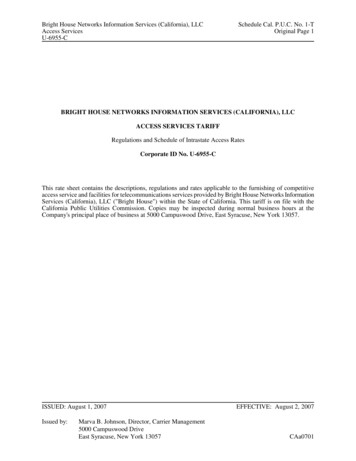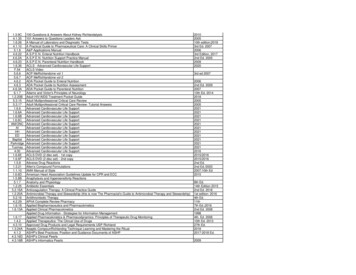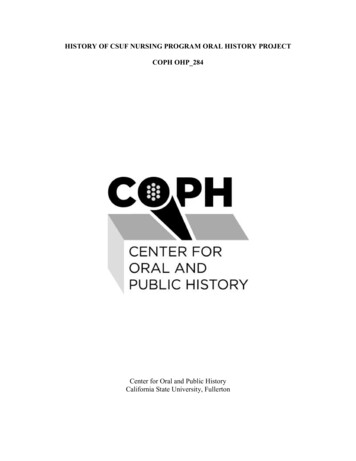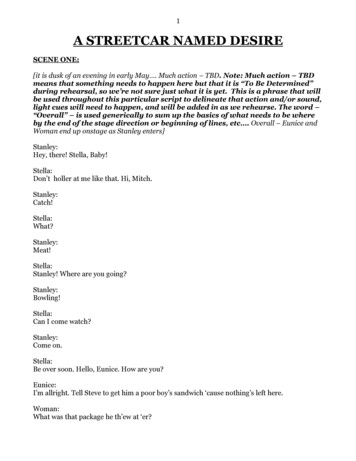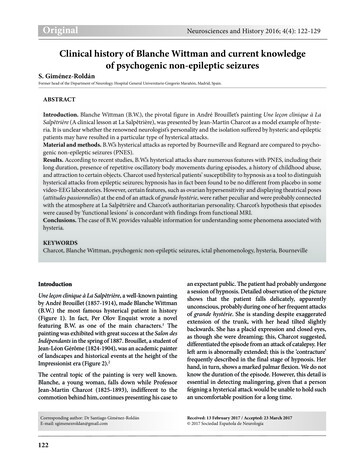
Transcription
OriginalNeurosciences and History 2016; 4(4): 122-129Clinical history of Blanche Wittman and current knowledgeof psychogenic non-epileptic seizuresS. Giménez-RoldánFormer head of the Department of Neurology. Hospital General Universitario Gregorio Marañón, Madrid, Spain.ABSTRACTIntroduction. Blanche Wittman (B.W.), the pivotal figure in André Brouillet’s painting Une leçon clinique à LaSalpêtrière (A clinical lesson at La Salpêtrière), was presented by Jean-Martin Charcot as a model example of hysteria. It is unclear whether the renowned neurologist’s personality and the isolation suffered by hysteric and epilepticpatients may have resulted in a particular type of hysterical attacks.Material and methods. B.W.’s hysterical attacks as reported by Bourneville and Regnard are compared to psychogenic non-epileptic seizures (PNES).Results. According to recent studies, B.W.’s hysterical attacks share numerous features with PNES, including theirlong duration, presence of repetitive oscillatory body movements during episodes, a history of childhood abuse,and attraction to certain objects. Charcot used hysterical patients’ susceptibility to hypnosis as a tool to distinguishhysterical attacks from epileptic seizures; hypnosis has in fact been found to be no different from placebo in somevideo-EEG laboratories. However, certain features, such as ovarian hypersensitivity and displaying theatrical poses(attitudes passionnelles) at the end of an attack of grande hystérie, were rather peculiar and were probably connectedwith the atmosphere at La Salpêtrière and Charcot’s authoritarian personality. Charcot’s hypothesis that episodeswere caused by ‘functional lesions’ is concordant with findings from functional MRI.Conclusions. The case of B.W. provides valuable information for understanding some phenomena associated withhysteria.KEYWORDSCharcot, Blanche Wittman, psychogenic non-epileptic seizures, ictal phenomenology, hysteria, BournevilleIntroductionUne leçon clinique à La Salpêtrière, a well-known paintingby André Brouillet (1857-1914), made Blanche Wittman(B.W.) the most famous hysterical patient in history(Figure 1). In fact, Per Olov Enquist wrote a novelfeaturing B.W. as one of the main characters.1 Thepainting was exhibited with great success at the Salon desIndépendants in the spring of 1887. Brouillet, a student ofJean-Léon Gérôme (1824-1904), was an academic painterof landscapes and historical events at the height of theImpressionist era (Figure 2).2The central topic of the painting is very well known.Blanche, a young woman, falls down while ProfessorJean-Martin Charcot (1825-1893), indifferent to thecommotion behind him, continues presenting his case toCorresponding author: Dr Santiago Giménez-RoldánE-mail: sgimenezroldan@gmail.com122an expectant public. The patient had probably undergonea session of hypnosis. Detailed observation of the pictureshows that the patient falls delicately, apparentlyunconscious, probably during one of her frequent attacksof grande hystérie. She is standing despite exaggeratedextension of the trunk, with her head tilted slightlybackwards. She has a placid expression and closed eyes,as though she were dreaming; this, Charcot suggested,differentiated the episode from an attack of catalepsy. Herleft arm is abnormally extended; this is the ‘contracture’frequently described in the final stage of hypnosis. Herhand, in turn, shows a marked palmar flexion. We do notknow the duration of the episode. However, this detail isessential in detecting malingering, given that a personfeigning a hysterical attack would be unable to hold suchan uncomfortable position for a long time.Received: 13 February 2017 / Accepted: 23 March 2017 2017 Sociedad Española de Neurología
Clinical history of Blanche Wittmanlessons, Charcot presented other young hystericalpatients, such as Geneviève, Justine Etchevery, AugustineGleizes, and Rosalie Lerroux.9 These patients wereprobably just as representative of hysteria as B.W., butthey did not have the privilege of appearing in a paintingalongside the entire Ècole de La Salpêtrière.Material and methodsWe gathered clinical data from Marie Wittman (Blanchewas the name of one of her sisters, which Marie wouldmurmur during her fits) from a book by Bourneville andRegnard, which devotes around 50 pages to this patient.10The description of the atmosphere at La Salpêtrière isbased on the reports of several patients.6,11,12 Informationabout Charcot’s ideas on hysteria, hystero-epilepsy, andhypnosis was gathered from his Oeuvres complètes13 andseveral biographical works on Charcot andBourneville.8,9,14-16 We also analysed recent medicalliterature on PNES to compare the condition to theattacks experienced by B.W.Figure 1. Main figures in André Brouillet’s Une leçon clinique à La Salpêtrière: Charcot, Babinski, Mme. Bottard, and Blanche WittmanResultsClinical history and progression of Blanche Wittmanaccording to Bourneville and Regnard (1878)Three other figures complete the scene. Joseph Babinski(1857-1932), Charcot’s chef de clinique, holds the patientas she falls. Some time later, Babinski would cast doubton his mentor’s pathogenic explanations and hypothesisethat hysterical attacks were caused by suggestion orpithiatism.3,4 Babinski is assisted by Marguerite Bottard(1822-1906), a secular nurse trained at the new nursingschool and who directed the Pariset ward, whereCharcot’s patients were institutionalised (Figure 3).5 Shewas still working in 1905, as reported by AlphonseBaudouin (1876-1956),6 a patient who had beeninstitutionalised at the centre. The face of Ecary is barelyvisible; this young nurse is the only of the 29 figuresdepicted whose surname is not known.7 This dramaticscene took place in one of Charcot’s popular Fridaylessons, which he gave in teaching rooms near his office.8The purpose of this paper is to review the case of B.W., amodel of hysteria at that time, comparing her clinicalhistory with current knowledge of symptoms associatedwith psychogenic non-epileptic seizures (PNES). In hisMarie Wittman, a dressmaker born in Paris, was admittedto the section for non-alienated epileptics at LaSalpêtrière on 6 May 1877; she was 18 years old. She wasblonde and had a lymphatic complexion, withvoluminous breasts and numerous freckles. She was 1.62Figure 2. Portrait of genre painter André Brouillet (A); cover of the catalogue of the painting and sculpture exhibition held in Paris in 1887 (Salondes Indépendants, 1887) announcing Brouillet’s well-known painting (B)123
S. Giménez-RoldánFigure 3. Secular nurse Marguerite Bottard in her later years (A) and onthe cover of the Sunday magazine Petit Journal (10 January 1898) after shewas awarded the medal of honour; the image shows her in one of thewomen's wards at La Salpêtrière (B). Image kindly provided by O. Walusinsky; date unknownFigure 4. Blanche Wittman at the age of 18, during her first stay at LaSalpêtrière (A) and some years later, with signs of obesity, probablywhile she was working as an assistant at Londe’s photography laboratory(B).metre tall and weighed 70 kg. She was unable to read andwrite and had barely average intelligence (Figure 4).in addition to ovarian hyperaesthesia immediatelypreceding attacks. “As in all hysterical patients”, she waskeen on collecting objects, for example a blue ball,artificial roses, bright-coloured prints, and religiousimages. In fact, she herself wore a scapular.He father, a Swiss carpenter, experienced violent fits ofrage; on one occasion, the man once “even threw B.W. outthe window”.10 Her mother, who died when B.W. was four(or when she was 14, according to another section of thesame book), experienced nervous attacks when she wasupset. B.W.’s parents had nine children, five of whom died(“four due to seizures and one due to epilepsy”).As a result of seizures B.W. experienced when she was22 months old, she became deaf and stopped speaking;however, she recovered her hearing and speech overtime. She began to work as a dressmaker when she was13; her employer harassed her whenever she was alone.She began a sexual relationship at the age of 15. Eightmonths later, she decided to admit herself to hospital toescape the situation. She reported having a young lovercalled Alphonse some time later. At that time, shesought refuge in a convent on the rue du Cherche-Midi,where she constantly suffered nocturnal attacks. Afterthat, B.W. had another lover called Louis. She thendecided to start working as a servant in La Salpêtrièrewith the idea that this may make it easier for her to beadmitted to that institution. She was eventuallysuccessful in this.Examination upon admission revealed righthemianaesthesia and decreased sensitivity in the left arm,124Barely seven days after her first admission, she began toexperience attacks with identical stages to those describedby Charcot: epileptoid, generalised clonus, and delirium.She was reported to have episodes lasting several hoursin which she would keep her eyelids closed, foam at themouth, jerk her arms and back, and become rigid. B.W.moved her head from side to side and raised it from thepillow for several seconds while she flexed and extendedher legs repeatedly. She mumbled; the only intelligibleword was “Blanche”, the name of one of her sisters. Dueto B.W.’ s voluminous abdomen, it was not possible tocontinue with ovary compression.In the following days, the patient complained of “asensation of a ball going up and down constantly”.“Normal vaginal secretions” were found on multipleoccasions, and attacks recurred uncontrollably (on 9December 1877, she suffered up to 54 attacks in sixhours). Attacks ceased with inhalation of amyl nitrate, themost effective of all methods tested at the time. On 11May 1878, B.W. displayed such violent behaviour thatCharcot decided to refer her to the service directed byDelasiauve, Bourneville’s former master, where shecontinued under observation. Her attacks persisted
Clinical history of Blanche Wittmandespite doctors placing ether-soaked compresses againsther nose.It was agreed that she should wear an ovary compressor(Figure 5), a device intended to prevent hysterical attacks.The Ramsden machine was used to produce staticelectricity in order to make sensitivity reappear in theright side of her body. On 22 February 1879, B.W.’smedical history notes that “thankfully, her menstruationhas returned”, although she experienced ten hystericalattacks that same morning.During delirium, B.W. reproduced love scenes; on otheroccasions, she reported being in a cemetery or seeing achild trapped under debris. “I cursed my parents, only theearth is familiar to me!”, she once exclaimed. On otheroccasions, she saw “animals, snakes coming out of a box”,and exclaimed “A naked woman! Oh, my God, I’m goingto die!”. Utterances were sometimes unintelligible:“Palapalapola!” [sic], she exclaimed, moving her arms likea windmill. Attacks of delirium were sometimes isolatedrather than associated with the previous stages (epileptoidand generalised clonus); response to ovary compressionor ether inhalation was unpredictable.Interestingly, delirium was on one occasion triggered bythe sight of a clerk carrying the deformed head of apatient with a giant tumour from the autopsy room to thephotography laboratory.10 Her clinical situation was socritical that she required a feeding tube, despite which shevomited the administered liquids. Once again,examination disclosed “moistness of the vagina andvulva”. Doctors used a pin to write the name of thehospital and B.W.’ s own name onto her skin, causing apapular erythema “measuring several centimetres”. B.W.was also reported to have bought tobacco, which shesmoked in a pipe. In the following months, she went onto experience anaesthesia of her extremities, contractures,and stomach complaints, as reported in the 28 pagesdedicated to this patient.The tragic fate of Blanche WittmanOn 11 October 1889, B.W. returned to La Salpêtrière forthe third time, on this occasion not as a patient but asan assistant at the photography laboratory directed byAlbert Londe (1858-1917), a pioneering medicalphotographer.17,18 A year later, Londe became thedirector of the new radiology department, with B.W.joining him. This was the beginning of another tragicperiod in her life, ending with her death in August 1909Figure 5. Ovary compressor, a metal device used at La Salpêtrière to prevent hysterical attacks. Understandably, Charcot admitted that this devicecould not be worn for extended periods.at the age of 56, due to a haemorrhage of undeterminedorigin. As Baudouin put it after visiting the hospitalwhere he had trained6:As I said before, Blanche was one of the first radiology assistants; she was also one of the early victimsof radiation-induced cancer, a disease that ravagedthe pioneers of this new discipline, causing themto lose limbs. She stoically endured the last agonising days of life. She suffered one amputation afteranother, beginning with one finger, soon followedby several others, then her hand, her forearm, andfinally her entire arm; then it moved to the otherside.RemarksThe Swedish writer Per Olov Enquist’s novel The story ofBlanche and Marie describes the probably untruerelationship between B.W. and Marie Curie, MariaSalomea Sklodowska (1867-1936), the pioneer inradioactivity research and two-time recipient of the Nobelprize.1 Although the novel purports to be based onhistorical events, it presents B.W. as Professor Charcot’slover. According to the story, B.W. “loved him more thanher own life” despite Charcot tormenting her with anovary compressor.1 After multiple amputations, B.W. waslittle more than a talking head and trunk, and spent therest of her days on a wooden cart, propelling herselfaround with her stumps. The ambiguous relationship125
S. Giménez-Roldánsymptom disorders is not infrequent.28 However,opisthotonos, a frequent manifestation of hysteria at LaSalpêtrière, is rarely reported today.24The atmosphere: the girls of La SalpêtrièreFigure 6. Studio photograph of Jane Avril, born Jeanne Louise Beaudon,showing her skills as a Moulin Rouge dancer (A). Poster promoting theMoulin Rouge, by painter Toulouse-Lautrec (B)between B.W. and Marie Curie unfolds under the deadlygreen glow of radium. The medical literature haspublished letters decrying the novel’s lack of historicalrigour.19Some manifestations of hysterical attacks have beenreported to be exclusive of patients at La Salpêtrièredue to the spread of a “culture of hysteria” at thatinstitution, as Hippolyte Bernheim, a bitter enemy ofCharcot, ironically stated.4 The final stage of delirium,associated with exclamations of amorous content,hallucinations, and ecstasy or even demonic cries, ns have also been reported in small,isolated communities in the Appalachians.29 Anotherpeculiarity of the hysterics at La Salpêtrière was thealleged ovarian hypersensitivity; this symptom wasdescribed as a state of sexual arousal manifesting asvaginal lubrication, which doctors attempted to controlwith cruel devices designed to compress the ovaries.B.W. possibly suffered generalised epilepsy with febrileseizures plus (GEFS ), a genetic disorder caused bymutations in the GABA(A) receptor gamma 2 subunit.20,21This is supported by B.W.’s personal and family history:four of her siblings experienced seizures duringchildhood, as she herself did when she was 22 monthsold, resulting in delayed language acquisition. Charcotdrew a clear distinction between epilepsy andpsychogenic seizures; these conditions co-occur in barely10% of all epileptic patients.22Bernheim was not the only one to criticise Charcot’smethods; William R. Gowers (1845-1915), probably thebest known British neurologist, also mistrusted the tenseatmosphere at La Salpêtrière. Gowers took employmentat the National Hospital for the Paralysed and Epileptic,in Queen Square, London, in 1870. Only one of the 360outpatients he received during his first year there wasdiagnosed with hysteria.30 La Salpêtrière, in contrast,accommodated numerous young women aged 15 to 30years, many of whom were abandoned unmarriedmothers; these women lived in a closed-off atmosphereamong epileptic patients and bedridden elderly womenand had to live with an unbearable stench.31Bourneville and Regnard’s thorough descriptions ofB.W.’s hysterical attacks are surprisingly similar to thesymptoms associated with PNES as we know themtoday.10 B.W.’ s father had a violent personality and shewas sexually abused by her employers duringadolescence.23 Furthermore, she displayed oscillatorymovements of the head and trunk during the attacks24;episodes were prolonged and she kept her eyes closedduring her hysterical fits. All these features are currentlyassociated with PNES.26 In line with B.W.’ s peculiar,childish habit of collecting small toys, the literaturereports that a high percentage of patients with PNESbring a stuffed animal to the video-EEG monitoring unit(the teddy bear sign).27 An association with other somaticAnother remarkable patient at La Salpêtrière was dancerJane Avril, born Jeanne Louise Beaudon (1868-1943)(Figure 6). Jane Avril was made famous by the painterToulouse-Lautrec, a passionate admirer who paintedseveral posters featuring the dancer to advertise theMoulin Rouge. She was admitted to La Salpêtrière on 28December 1882 under Charcot and institutionalised inthe Pariset ward for epileptics and hysterics. Although shewas only fourteen, she had had an eventful life, being thedaughter of an Italian marquis and an abusive mother.Some fifty years later, she published her memoirs, aninvaluable testimony of the atmosphere behind the scenesat La Salpêtrière, which she witnessed for 18 months,surrounded by ‘stars of hysteria’.11126
Clinical history of Blanche Wittman“It was hilarious to see the pride in the faces of those crazygirls as they were chosen by the master.” She wasastounded by the number of “wise men” who came towitness such a farce. The girls at La Salpêtrière told JaneAvril their secret: they would stop twisting and contortingonce doctors moved away from their beds. “Come andpress hard on my ovaries”, they would say. That simpleprocedure was supposed to be able to suppress hystericalattacks immediately. The atmosphere at La Salpêtrièrewas infectious, fuelled by the great interest these patientsaroused among the doctors.The situation at La Salpêtrière, however, was no differentfrom that of epidemic hysteria, or mass hysteria,32 aphenomenon occurring among adolescents and youngwomen living in isolation, for example in orphanages,33and in celebrations with a strong sentimentalcomponent.34Differential diagnosis of hysterical attacks according toCharcot: hypnosis as a placeboAt that time, the complexity of epileptic manifestationswas still to be fully understood; it is thereforeunderstandable that Charcot placed so much emphasison differentiating hysterical attacks from epilepticseizures. This ultimately led him to apply hypnosis, whichhe considered a useful tool for the differential diagnosisof hysteria. Hysterical patients, such as B.W., wereparticularly susceptible to hypnosis, whereas those withepileptic seizures were not. As Charcot himself was notvery skilled in this technique, he referred refractory casesto Axel Munthe, one of his former students. Munthe usedhypnosis exclusively to reduce pain during childbirth orsurgery.35 B.W.’ s unusual susceptibility to hypnosiscontinued while she worked as an assistant at thephotography laboratory directed by Albert Londe, anexceptionally talented photographer who had nouniversity studies (Figure 7).36The use of placebo-based suggestive seizure induction fordiagnostic purposes is still controversial.37,38 Charcotwondered whether inducing seizures was immoral:“Probably it is not, if it helps in providing treatment to aprocess that otherwise would have no cure”. In any case,the validity of hypnosis was confirmed by severalrenowned psychologists at La Salpêtrière, includingCharles Féré and Alfred Binet. They opposed the purelypsychological approach to hypnosis of the Nancy School,founded by Hippolyte Bernheim (1837-1919).5,39 TheFigure 7. Albert Londe hypnotising Blanche Wittman, 1880. Taken fromO. Walusinski.36 The picture seems to have been taken in a photographystudio, which suggests that B.W. may have voluntarily feigned a hystericalattack for the camera.neuroanatomist Jules Bernard Luys (1828-1897), acontemporary of Charcot’s, also conducted publicdemonstrations of hypnosis at La Charité, and evenestablished a hypnotherapy laboratory for that purpose.40Hysteria or simulation?Charcot was well aware that some of the neurologicaldisorders he studied might in fact be feigned.41 As B.W.explained in an interview twelve years after her master’sdeath6:“Listen, Blanche. I know there are things you don’twant to talk about, but you’ve known me for a longtime and you know that I have no intention to makefun of you. I’d like you to explain something aboutthe attacks you used to have.” After hesitating amoment, she replied: “Well! What do you want toknow?”. “They claim that all these attacks were127
S. Giménez-Roldánfaked, that the patients pretended to be asleep andthat the whole thing was a joke on the doctors.What’s the truth in all that?”. “None of it’s true. It’sall lies; if we fell asleep, if we had attacks, it wasbecause we were helpless to do otherwise. What’smore, it was very unpleasant”. And she added:“Fakery! Do you think it would have been easy tofool Monsieur Charcot? Yes, there were tricksterswho tried; he simply gave them a look that said: ‘Bestill’. That was how this ‘confession of a hysteric’ended, with a homage to the great deceased neurologist.There is no reason to think that the mechanismsunderlying B.W.’ s attacks were different from those ofpatients with PNES today. Therefore, both entities haveseveral features in common. In the same way as stressfulsituations may cause epidemic hysteria in isolatedpopulations, the atmosphere at La Salpêtrière wasprobably responsible for certain peculiar characteristicsof hysteria, such as the trigger factors for hysteric attacksand the fact that these stopped with compression of theovaries. MRI may show altered routes of information andemotional processing, as well as abnormal copingstrategies, in patients with PNES; these patients maytherefore be unable to cope with emotional trauma.23 HadMRI been available at that time, Charcot would probablyhave reported similar findings in B.W.ConclusionsDespite minor phenomenological differences betweenhysteria and PNES, B.W. represents a key case forunderstanding some of the characteristics of hystericalattacks and current PNES.Conflicts of interestThe author has no conflicts of interest to declare.References1. Enquist PO. e story of Blanche and Marie. London: Vintage Books; 2007.2. Telson HW. Une leçon du Docteur Charcot à La Salpêtrière: lithograph by Eugene Pirodon based on a painting(1887) by André Brouillet. J Hist Med Allied Sci.1980;35:58-9.3. Poirier J, Philippon J. Renewing the fire: Joseph Babinski.Front Neurol Neurosci. 2011;29:91-104.4. Bogousslavsky J. e mysteries of hysteria. Neurosci Hist.2014;2:54-73.5. Walusinski O. Keeping the fire burning: Georges Gilles de laTourette, Paul Richer, Charles Féré and Alfred Binet. FrontNeurol Neurosci. 2011;29:71-90.6. Baudouin A. Quelques souvenirs de La Salpêtrière. ParisMédicale. 1925;21: 517-20.1287. Signoret JL. Une leçon clinique à La Salpêtrière (1887) parAndré Brouillet. Rev Neurol (Paris). 1983;139:687-701.8. Guillain G. J.M. Charcot: 1825-1893, his life - his work. NewYork: Paul B. Hoeber; 1959.9. Goetz CG, Bonduelle M, Gelfand T. Charcot: constructingneurology. New York: Oxford University Press; 1995.10. Bourneville DM, Regnard O. Iconographie photographiquede la Salpêtrière (Service de M. Charcot). Paris: V. AdrienDelahaye & Co.; 1878.11. Bonduelle M, Gelfand T. Hysteria behind the scenes: JaneAvril at the Salpêtrière. J Hist Neurosci. 1998;7:35-42.12. Alvarado CS. Nineteenth-century hysteria and hypnosis: ahistorical note on Blanche Wittmann. Austr J Clin ExperHypn. 2009;37:21-36.13. Charcot CM. Oeuvres complètes. Leçons sur les maladies dusystème nerveux recueillies et publiées par Bourneville.Paris: Bureaux du Progrès Médicale; 1892.14. Marie P. Éloge de J.M. Charcot. Rev Neurol. 1925;5:731-45.15. Satran R. Charcot the clinician: the Tuesday lessons. GoetzCG, tr. New York: Raven Press; 1987.16. Zarranz JJ. Bourneville, a neurologist in action. NeurosciHist. 2015;3:107-15.17. Aubert G, Laterre C. Neurosciences, photography and cinematography in the 19th century. J Hist Neurosci. 1998;7:57-8.18. Broussolle E, Poirier J, Clarac F, Barbara JG. Figures and institutions of the neurological sciences in Paris from 1800 to 1950.Part III: neurology. Rev Neurol (Paris). 2012;168:301-20.19. Van Gijn J. In defence of Charcot, Curie, and Wittmann. Lancet. 2007;369:462.20. Koepp MJ. Hippocampal sclerosis: cause or consequence offebrile seizures. J Neurol Neurosurg Psychiatry. 2000;69:716-7.21. Audenaert D, Schwartz E, Claeys KG, Clases L, Deprez L,Suls A, et al. A novel GABRG2 mutation associated withfebrile seizures. Neurology. 2006;67:687-90.22. Lesser RP, Lueders H, Dinner DS. Evidence for epilepsy israre in patients with psychogenic seizures. Neurology.1983;33:502-4.23. Van der Kruijs SJ, Bodde NM, Vaessen MJ, Lazeron RH,Vonck K, Boon P, et al. Functional connectivity of dissociation in patients with psychogenic non-epileptic seizures. JNeurol Neurosurg Psychiatry. 2012;83:239-47.24. Giménez-Roldán S, Hípola-González D, de Andrés C, MateoD, Orengo-García F. Fenomenología crítica motora enpacientes no epilépticos con crisis psicógenas. Rev Neurol(Barc). 1998;27:395-400.25. Holtkamp M, Othman J, Buchheim K, Meierkord H. Diagnosis of psychogenic nonepileptic status epilepticus in theemergency setting. Neurology. 2006;66:1727-9.26. Syed TU, LaFrance WC, Kahriman ES, Hasan SN, Rajasekaran V, Gulati D, et al. Can semiology predict psychogenicnonepileptic seizures? A prospective study. Ann Neurol.2011;69:997-1004.27. Burneo JG, Martin R, Powell T, Greenlee S, Knowlton RC,Faught RE, et al. Teddy bears: an observational finding inpatients with non-epileptic seizures. Neurology.2003;61:714-5.28. Kuyk J, Swinkels WA, Spinhoven P. Psychopathologies inpatients with nonepileptic seizures with and without comor-
Clinical history of Blanche Wittmanbid epilepsy: how different are they? Epilepsy Behav.2003;4:13-8.29. Critchley EM, Cantor HE. Charcot’s hysteria renaissant. BrMed J (Clin Res Ed). 1984;289:1785-8.30. Scott A, Eadie M, Lees A. William Richard Gowers: 18451915: exploring the Victorian brain. Oxford: Oxford University Press; 2013.31. Walusinski O. e girls of the Salpêtrière. Front Neurol Neurosci. 2014;35:65-77.32. Boss LP. Epidemic hysteria: a review of the published literature. Epidemiol Rev. 1997;19:233-43.33. Giménez-Roldán S, Aubert G. Hysterical chorea: report ofan outbreak and movie documentation by Arthur VanGehuchten (1861-1914). Mov Disord. 2007;22:1071-6.34. Giménez-Roldán S. Los convulsionarios de Santa Orosia.Neurología. 2005;20:99-102.35. Álvaro LC. Axel Munthe: a model of values for current neurological practice. Neurosci Hist. 2014;2:15-25.36. Walusinski O. Le bâillement [Internet]. [s.l.]: O. Walusinski; 2001. Albert Londe (1858-1917): photographe à La Salpêtrière à l’époque de Jean-Martin Charcot; [accessed Feb 132017]. Available from: http://www.baillement.com/recherche/londe albert.pdf37. Benbadis SR, Agrawal V, Tatum WO. How many patientswith psychogenic nonepileptic seizures also have epilepsy?Neurology. 2001;57:915-7.38. Benbadis SR, Siegrist K, Tatum WO, Heriaud L, Anthony K.Short-term outpatient EEG video with induction in the diagnosis of psychogenic seizures. Neurology. 2004;63:1728-30.39. Binet A, Féré C. Le magnétisme animal. Paris: Félix Alcan;1887.40. Parent A, Parent M, Leroux-Hugon V. Jules Bernard Luys: asingular figure of 19th century neurology. Can J Neurol Sci.2002;29:282-8.41. Goetz CG. J.-M. Charcot and simulated neurologic disease.Neurology. 2007;69:103-9.129
Clinical history and progression of Blanche Wittman according to Bourneville and Regnard (1878) Marie Wittman, a dressmaker born in Paris, was admitted to the section for non-alienated epileptics at La Salpêtrière on 6 May 1877; she was 18 years old. She was blonde and had a lymphatic complexion, with voluminous breasts and numerous freckles.

